It's no wonder kids get a six week holiday off school. They may not work as hard as the grown ups, but school can be a stressful place - especially if you go somewhere like Hope's Peak Academy, as the original Danganronpa proved. A high rolling, high tier school that only took in the hand-picked elite of the country's elite - incredibly talented people known as ultimates - the was more to worry about than just exam results and making friends there. You had to kill your friends if you ever wanted to leave. With a real demon headmaster - a black and white teddy bear named Monokuma - in charge, and an entire class of students trapped inside an armour plated school, the recipe was set for a gripping murder mystery - and the Vita's finest game.
A direct sequel to Danganronpa: Trigger Happy Havoc - if you haven't played the original, you really need to before playing this, as not only does the story contain mega spoilers for the original, but it also won't make much sense without it - Danganronpa 2: Goodbye Despair starts off in a similar way. Waking up on a mysterious island with little in the way of memory (only a strange feeling of deja vu...), you awake to find a slightly unnerving pink rabbit called Usami that claims to be your teacher, who announces she's brought you here on a special school trip. With unlimited food, plenty of coconuts, and a crate of chilled beverages, it's shaping up to be a school trip to remember - but it turns out there's a bit of a catch, and not of the fishy kind. While you're free to do as you please on the island, and can frolic about in the sun all you like, it turns out there's a teensy, tiny clause no one mentioned before. There's no way you can leave. The planes at the airport have been disabled, the boats sunk, and the waters stretch for miles before you reach the nearest shore. For all intents and purposes, you're stranded - and there's only one way to get out. You guessed it - by mur- wait, what? Friendship!?
While the similarities are many, the school trip this time starts out in a different way, as Usami, the kind of the good cop to Monokuma's bad cop, wishes everyone could just get along. So long as you stick to a few ground rules, she'll make sure you're looked after on the island - with the number one law being to not kill anyone! Get on with each other well enough, and you'll collect the "Hope fragments", so you can prove Hope triumphs over Despair, and have the chance to get off the island. Sounds easy enough, right? Well, it would be - but then Hurricane Monokuma rolls in to shore.
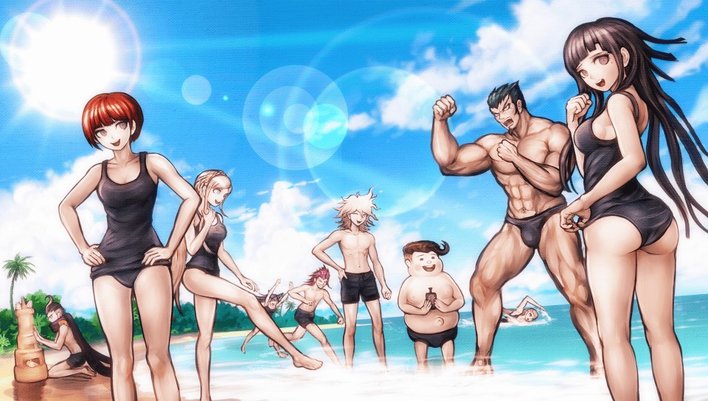
Fun in the sun? Not for long.
Crashing the school trip party before it's even got started, Monokuma is quick assert his authority. Usami's the teacher, Monokuma's the headmaster, so what he says goes. And what he says sounds familiar to anyone who's played the first game. After remodelling Usami after himself (now known as Monomi), Monokuma is quick to remind everyone that they're stranded - but he's willing to give you a different way to escape. Forget making friends and the lovey dovey slush - all you have to do if you want to graduate is to kill someone, and escape from the class trial without being found guilty. Should a murder occurs, it's up to the remaining classmates to work together and figure out who-dunnit - guess right, and Monokuma will arrange a "special punishment" (read: execute) them, and spare the rest of you - but get it wrong, and the murderer will walk free from the island, before Monokuma executes the rest of you instead.
So begins your adventure on Dangan Island, as you, and your fellow classmates attempt to adjust to life under constant suspicion. While gathering the hope fragments by making friends with each other still has the potential to bring your holiday to a happy conclusion, it seems an almost impossible goal. After all - with murder being the easiest way to get off the island, and no end in sight, how can you be sure the folks you're trying to befriend aren't planning on stabbing you in the back as soon as they've won your trust?
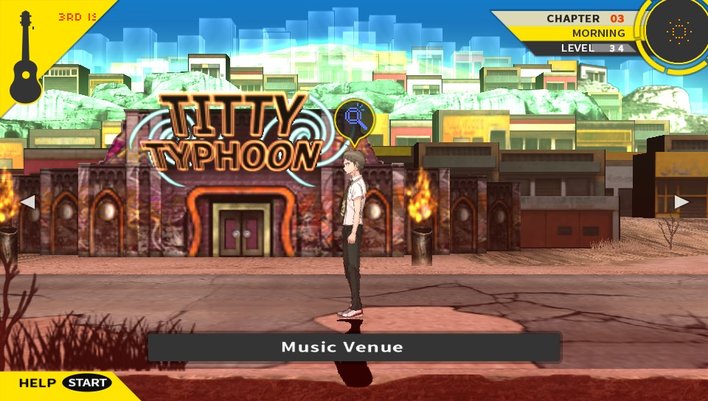
Moving around the island is done in from a 2D perspective. In case you're wondering, that's a music venue we're standing in front of. Filth.
As with the first game, everyone trapped on the island is some sort of "Ultimate" - an elite student, cherry picked by the academy as being the very best at something. Whether it's the muscle bound, faeces obsessed Ultimate Team Leader Nekomaru Nidai, the baby faced Fuyuhiko Kuzuryu, known as the Ultimate Yakuza, or the slightly creepy, purple haired, and somewhat insecure Kazuichi Souda, the Ultimate Mechanic, it's a game that takes all types - even if it is hard to see how some of the ultimates fit into the game. While the incredibly clumsy and shy Mikan Tsumiki has an obvious role to play as the Ultimate Nurse, it's a bit trickier to see why the bratty, and incredibly annoying Hiyoko Saijoni found her way to the school as the Ultimate Traditional Dancer.
Perhaps more disappointingly, the characters all seem to have less, well, character this time around. While the original game told a very tight, twisting narrative that had you guessing until the very end - and, perhaps most importantly, made you genuinely care for the characters - there are few here that'll have you feeling the same way. That's not to say there aren't some good characters in here - the aforementioned Kazuichi has his moments, and Ibuki, the Ultimate Musician has more character than most of the other students put together - but the overall feeling here is of an adventure that's slightly duller, and less engaging than the original. Of course, the first game pretty much managed to catch lightning in a bottle, so it was always going to be hard to equal it - and Danganronpa 2 at least does a good job of coming close.
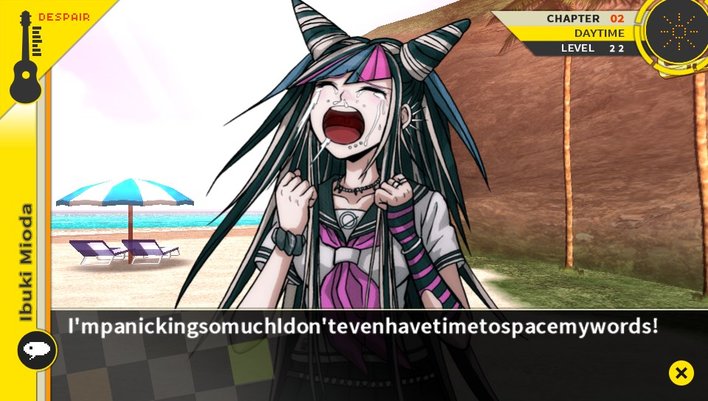
Iknowwhatyoumean!
Your time on the island will be divided between two very different kinds of play, as the game's effective split up into "things that happen before a murder" and "things that happen after". During your daily life (before someone gets killed), you're able to roam the island freely, moving from building to building as you search for clues as to why you're trapped on the island in the first place, where your memories have gone, and how you'll ever manage to get out. With pretty much constant story sequences keeping the plot moving, and some ever colourful exchanges between the characters, this is where you'll get to find out more about the island, and get to know each of the characters. Every now and then, you'll also find yourself with some free time, where you can choose to either get some rest, explore as you see fit, or go and spend some more time with one of the characters, in a minigame that works kind of like a dating game. By giving them a present, and guessing what they like correctly, they'll tell you a little bit more about themselves and their back story - and you'll get a hope fragment in return. Collect them all, and "something good might happen" - or so we've been told. Of course, you can't manage that on a single play through.
Still, it wouldn't be a Danganronpa game without plenty of murders, and Danganronpa 2 delivers. While you may start with 16 students, it doesn't take long for the knives to come out, with the oddly cheery jingle of the body discovery announcement, which plays as soon as three people find a body, never fails to send a shiver up your spine. Upon hearing the announcement, it's up to you to explore the scene of the crime, as you examine anything and everything you can as you hunt for clues, evidence, or anything else that may point you in the way of the killer. Everything you find that might be of use becomes a "truth bullet" - and they'll come in handy later in the trial.
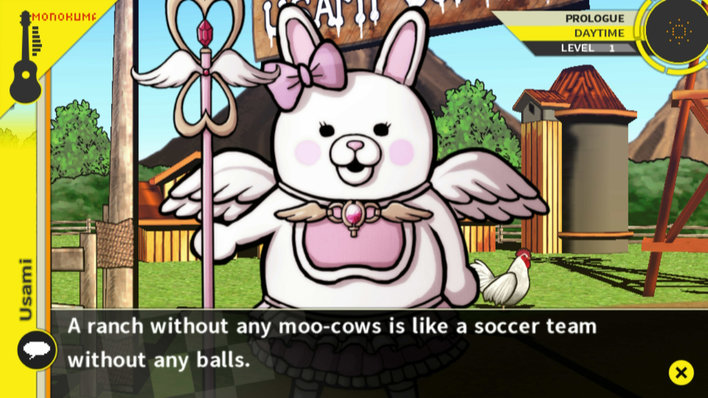
Zing!
Once you've finished examining the crime scene, it's off to the trial itself - and this is where things get really tense. With Monokuma now becoming the judge and executioner, it's up you to form the jury, and argue it out with your classmates as you try to figure out whodunnit. And as you'd likely expect from a game like this, that's never easy.
The trial is divided up into segments, as you and your classmates edge ever closer towards the truth. In each segment, known as a non-stop debate, you get to sit back and watch as your classmates tell you what they think happened, and have a bit of an argument with each other, with the words thrown up on screen. Every now and then, some of the words they say will be highlighted in orange - and those represent a potential weak point in an argument, and a target for your truth bullet. All you have to do to move on to the next segment is to find the contradiction in the argument, and choose the right truth bullet to blast through their lies/misconceptions, putting the Ace Attorney to shame. Of course, there's a catch, as should you choose the wrong option, your classmates will lose faith in you - and even start to suspect you. Should you run out of health, you'll be found guilty, and it'll be game over.

Just so we can avoid spoilers, here's a screen from the Japanese version of the trials. Smash through the orange words with your truth bullets!
On Danganronpa, that was about all there was to the class trials - and they were great. Unfortunately, Danganronpa 2 decided to dodge the truth bullet marked "if it ain't broke, don't fix it", and instead comes with a variety of tacked on "improvements" - the only problem being, few of them really make things better. One of the simpler changes is that now not only can your truth bullets blast through contradictions in statements, but they can also be used to, er, fire at statements you agree with.
The other new features are a mixed bag. The Logic Dive, which puts you on a skateboard, sliding through a neon tunnel, asking you to dodge obstacles before choosing a branch to answer a question (i.e. "Which was the murder weapon?" Left for the candlestick, right for the guitar pick) is OK, but the new and "improved" hangman's gambit is a mess. With an sort of anagram to solve, you have a number of blank spaces at the bottom of the screen, and a collection of letters sliding slowly across the screen in all directions. What you have to do is use a cursor to pick up the letter you want to use, find another copy of that letter sliding across the board, and fire it at it to combine them, and add that letter to your grid. If it sounds confusing, it's because it is - and when the screen fills with dozens of letters sliding in all directions, and when you lose health when two letters that aren't the same collide, you'll find yourself haemorrhaging health for no reason.
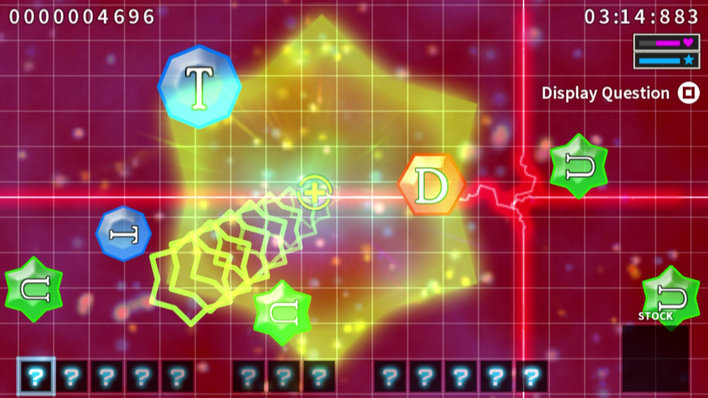
What's happening!
Another new - and poor - addition to the class trials is counter arguments, where your classmates will randomly decide they have a bone to pick with you, and it's up to you to either use the analogue stick, or the touch screen to slice through all of their arguments as they pop up on screen - just not the ones highlighted in orange. As soon as an orange line pops up on screen, you have to stop slashing, and fire a truth bullet at it instead - the only problem being, you often have no idea what you're supposed to fire, because you've been destroying the rest of the text so fast you haven't been able to follow what the argument's all about.
Luckily, though, these mini-games are few and far between, and for the most part, the trials are still back and forth fun. The more you move through them, the more red herrings you'll find, and the more confusing things will get, before (in true murder mystery way), whodunnit becomes clear, and the class trial finishes. All that's left to do then is to put together everything that happened, and prove the murderer is the one who did it, by putting the right panels into a kind of comic book, to retrace everything that happened in the murder. It's a pretty cool way of making sure you're following the story - and one of few things that's been improved since the original, by way of the handy captions that now describe each panel.
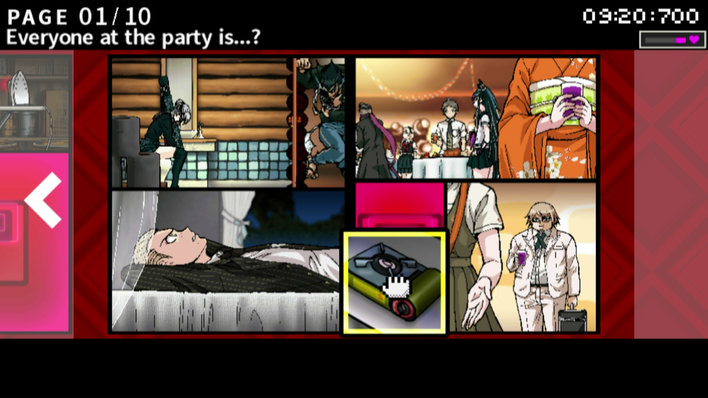
Little captions tell you what each picture represents, making figuring out which panel goes where a little bit easier.
And while the trials are still fun, for the most part, it's disappointing that they - and the game in general itself - never really captures the excitement of the original. While it may not be clear whodunnit at the start of the trial, there's a distinct lack of those "WTF" revelations that had you doubting everything you've ever learnt, possibly because of the poorer writing this time around. Some exchanges don't really seem to make all that much sense, and the characters all feel a lot weaker than the last outing.
Choosing the right piece of evidence, and the right statement to back up/attack is harder too - we found ourselves totally stuck on several occasions, having to take the old point and click strategy of trying everything with everything else to find something that fits. Thankfully, it didn't take too long to luck into the right option - but it probably shouldn't have happened in the first place.
Still, perhaps the greatest test of a story driven game is whether you'll care enough to play through to the end. The answer here is a definite yes - but perhaps not as resoundingly as with the original. While the writing may be weaker, you're still care about the characters; while the plot may be more ambiguous, you still want to find out what happens at the end. In fact, perhaps the biggest weakness in Danganronpa 2 is that it's a sequel to a game that got almost everything so perfectly right the first time round. Compared to that, even the finest visual novels seem a little bit pale - but that doesn't mean Danganronpa 2 isn't well worth playing. Just don't expect too much from the ending.
Format Reviewed: PS Vita





















